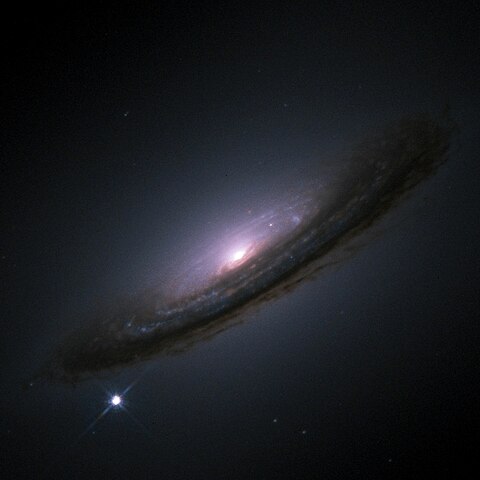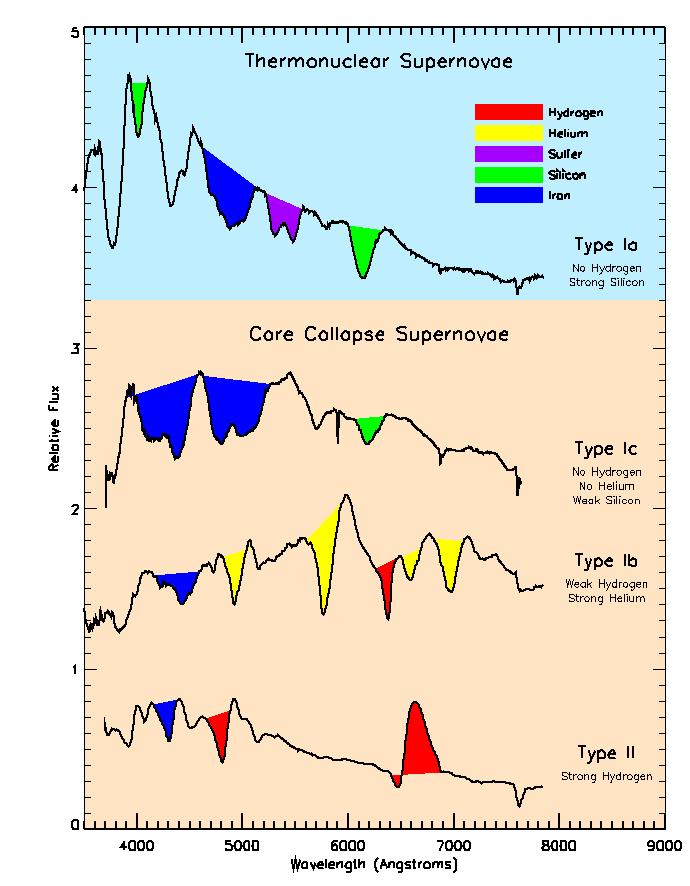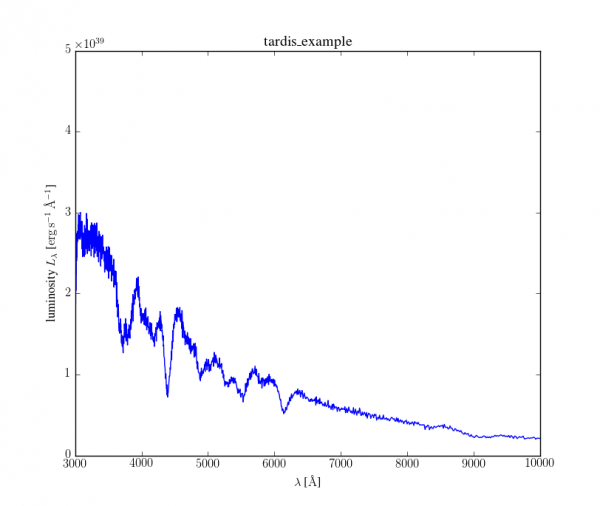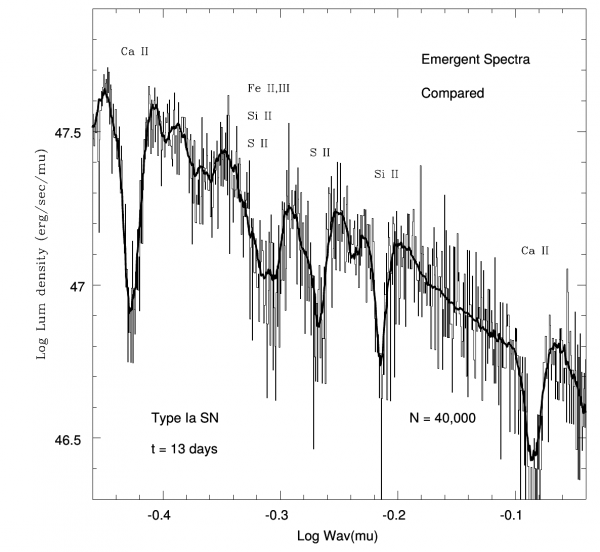User Tools
Table of Contents
TARDIS SoCIS 2016 Ideas Page
A bit of astronomy and astrophysics background information
A supernova (here we show SN1994D in the Galaxy NGC4526 - image source: wikipedia) marks the brilliant death throes of a star, during which it outshines its entire galaxy. It not only marks death, though: supernova ejecta change the evolution of the universe and enable the formation of planets and life as we know it. From the iron in your blood to the gold in your jewelry, supernovae return heavy elements assembled from the primordial hydrogen and helium left after the big bang.
There are still many mysteries surrounding supernovae (e.g. their precise origins, inner workings, …). One way to study these objects in more detail is to split the light coming from these objects into its components (like using a prism) and analyzing the resulting data (which is called a spectrum). Here, we show spectra (black lines) of a number of different supernova types (image courtesy Daniel Kasen and LBL). Different chemical elements present in the supernova leave their mark on the spectra by imprinting characteristic features, so-called atomic lines (regions highlighted in colour). Thus, studying and interpreting such spectra allows us to identify what supernovae are made of.
With sophisticated computer simulations astronomers try to reproduce the observed spectra to draw conclusion about the properties of the supernova ejecta and ultimately the explosion mechanism and progenitor stars. TARDIS is such a numerical code. It calculates theoretical spectra based on a number of input parameters, such as the supernova brightness and the abundances of the different chemical elements present in the ejecta (e.g. Oxygen, Silicon, Iron, etc.). The main idea for this procedure is that by finding a close match between theoretical and observed spectra we identify the parameters that actually describe the supernovae.
The TARDIS project
As mentioned in the background information above, TARDIS is a scientific tool (more specifically a Monte Carlo radiative transfer code) whose primary goal is the calculation of theoretical spectra for supernovae. Below, you find the typical result of a TARDIS calculation. It shows the calculated synthetic spectra for a simple supernova model. This particular setup (tardis_example) is officially provided by the TARDIS collaboration on the documentation.
TARDIS aims to be an easy to use piece of software for research and training purposes. Unlike many other scientific codes, we have purposefully made it open-source. This enables scientists to use the code to analyze their observations, but also to review the code and potentially fix errors.
List of SoCIS 2016 project ideas
In the TARDIS collaboration we first establish a detailed plan on implementing new features before starting the actual work. This is an important step that ensures that the entire TARDIS collaboration is informed about the development efforts and that the team members can help shape the ideas during the discussion phase. We call these documents TNo PEP - TARDIS Enhancement Proposals. We already have a great list of ideas at https://github.com/tardis-sn/tep that we need help with. Some of these we have specially selected for SoCIS 2016 and are listed with specific “warm-up” tasks below. But feel free to propose your own TEP and make a PR on that.
If you use one of our TEPs, you can definitely add more detail to the implementation, but what we really want to see is a detailed timeline with milestones that shows us that you have thought about how to implement the feature in three months. For any questions about the projects, please ask on our mailing list tardis-socis-2016@googlegroups.com or on Gitter.
Writing Models to file
Difficulty: Easy
Astronomy knowledge needed: None
Mentors: @wkerzendorf, @yeganer
Programming skills: Python
Related TEP: TEP002
SoCIS Application Tag: model output
Description: TARDIS studies how light travels through a supernova and how it ultimately appears to us. We are researching this process and thus are interested in analyzing TARDIS outputs in great deal. This means that we aim at capturing the full state of a TARDIS calculation in more detail. TEP002 describes the ideas in some detail and we want you to help us to implement these.
Your first objective if you choose to accept the mission: Write a `.to_hdf` function for the `MontecarloRunner` class in TARDIS that saves some of the important arrays to an HDF5 file.
New module for the creation of spectra
Difficulty: Hard
Astronomy knowledge needed: Medium
Mentors: @unoebauer, @chvogl
Programming skills: Python, C, Cython
Related TEP: TEP005
SoCIS Application Tag: spectral synthesis
Description: TARDIS's main task is to create spectra that can be compared with observations. In order to use TARDIS to estimate parameters of real supernovae, we need to select TARDIS simulation parameters in such a way so as to produce spectra resembling those of real supernovae. When having a real spectrum, however, we don't know what those simulation parameters may be.
We use a method that uses random numbers to simulate the flow of light through the supernova envelope. But that also generates noise in the final output spectrum. We would like to implement a better solution for this, by using the formal integral solution developed by Lucy 1999, as proposed in TEP005. In the figure below, the benefit of this new spectrum reconstruction method (shown as the thick black line) compared to the standard Monte Carlo counting approach (noisy histogram) is illustrated (image taken from Lucy 1999, fig. 4):
This project requires a bit of physics knowledge.
Your first objective if you choose to accept the mission: Implement a simple counting estimator, storing the number of Monte Carlo packets that come into resonance with each atomic line transition. For this, look into the main Monte Carlo part of TARDIS and find the location where the j_blue_estimators are incremented. This would be a good place to insert your counters.
“Bonus objective:” Once the counter is properly working, you could try to implement an estimator for the line absorption rates (see Equation 11 in Lucy 1999). In an additional step, these level absorption rates could be used to calculate level absorption rates (see Equation 19 in Lucy 1999).
Hints: As mentioned above, understanding what incrementing j_blue_estimators means, is the key to the first objective. Physically, it measures the energy of all photons which can come into resonance with a particular line. Photons/packets not necessarily have to interact with the line to be counted. The relativistic Doppler shift just has to shift their frequency far enough so that it matches the frequency of the line. Taking all this into account, you will realise that the j_blue_estimators behave very similar to the counter you are supposed to implement.
Handling nuclear decay in TARDIS
Difficulty: Medium/Hard
Astronomy knowledge needed: Low/None
Mentors: @unoebauer, @wkerzendorf
Programming skills: Python
Related TEP: TEP007
SoCIS Application Tag: nuclear decay
Description: Supernova are powered by the decay of radioactive elements and thus if we want to simulate supernovae we also need to take this physical process into account. Currently, this is done in a very difficult and not easily extensible way in TARDIS. We have thought about adding more support for this and need your help with this.
Your first objective if you choose to accept the mission: Work on PR https://github.com/tardis-sn/tardis/pull/409 and try to get as far as possible it finish it.
Tighter integration of Atomic Data, Plasma and Model
Difficulty: Hard
Astronomy knowledge needed: Low
Mentors: @yeganer, @wkerzendorf
Programming skills: Python
Related TEP: TEP008
SoCIS Application Tag: atomic/model/plasma integration
Description: TARDIS needs to calculate the Plasma state very often during the runtime. TARDIS should also be able to use different modules with different approximations how to calculate the plasma state. Last year we updated the plasma module to allow a more modular approach. While we got far, this new framework is not yet completely embedded in the code and we will need your help with finalizing the integration.
Your first objective if you choose to accept the mission:
Add a class to the plasma part that dynamically provides the tables of a hdf5 file to the networkx graph.





